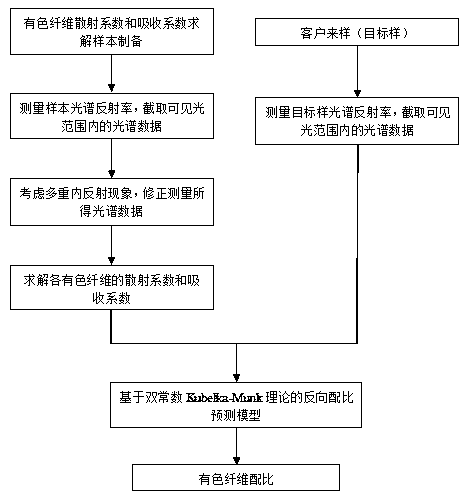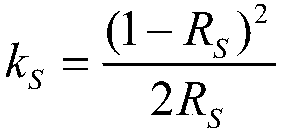A Colored Fiber Mixing and Matching Method Based on Double Constant Kubelka-munk Theory
A colored fiber, double constant technology, applied in the field of colored fiber mixing and color matching, can solve problems such as internal reflection of light, and achieve the effects of reducing trial spinning waste, improving applicability, and improving prediction accuracy.
- Summary
- Abstract
- Description
- Claims
- Application Information
AI Technical Summary
Problems solved by technology
Method used
Image
Examples
Embodiment
[0045] Embodiment comprises the following steps:
[0046] 1) Select a colored fiber as a reference standard, and prepare a calibration sample with a ratio of 100%;
[0047] Embodiment Select the colored fiber S with the highest brightness as the calibration colored fiber for preparing the calibration sample, and prepare a calibration sample with a ratio of 100% according to the shape of the target sample (sliver, fabric or yarn, etc.).
[0048] 2) For each colored fiber, prepare a single-component colored fiber sample with a ratio of 100%, and then mix each colored fiber with the calibrated colored fiber in the ratio of c:(1-c) to prepare A mixed sample, as a solution sample for the scattering coefficient and absorption coefficient of each colored fiber;
[0049] During specific implementation, it is recommended to take c as 40%.
[0050] In the embodiment, if the four colored fibers A, B, C and D do not contain the calibrated colored fiber S of 1), it is necessary to prepar...
PUM
 Login to View More
Login to View More Abstract
Description
Claims
Application Information
 Login to View More
Login to View More - R&D
- Intellectual Property
- Life Sciences
- Materials
- Tech Scout
- Unparalleled Data Quality
- Higher Quality Content
- 60% Fewer Hallucinations
Browse by: Latest US Patents, China's latest patents, Technical Efficacy Thesaurus, Application Domain, Technology Topic, Popular Technical Reports.
© 2025 PatSnap. All rights reserved.Legal|Privacy policy|Modern Slavery Act Transparency Statement|Sitemap|About US| Contact US: help@patsnap.com



